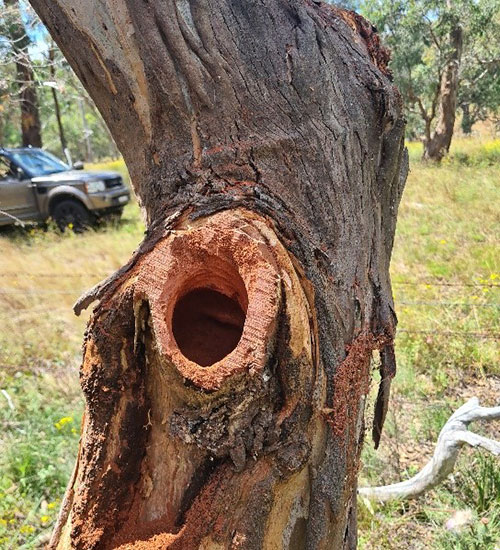Driving Corridor Connectivity project
Increasing and improving the condition of Grassy Box Woodland across the Central Tablelands
Running from 2018 to 2023, the Driving Corridor Connectivity project assisted private land managers to improve the condition, extent and connectivity of Box Gum Grassy Woodland communities. Projects included enhancing existing remnant woodland areas through habitat planting and augmented hollow installation. As well as revegetation activities to improve landscape connectivity.
We worked with local councils to identify roadside sites of high conservation value. The aim of the Driving Corridor Connectivity Project was to increase the extent of these areas by working with adjacent landholders to improve the condition of the Grassy Box Woodland on their properties.
Whilst this project is now complete, more Grassy Box Woodland projects will be undertaken in 2023. Keep an eye on our newsletter to ensure you can take advantage of future projects.
On-ground works undertaken
On-ground work delivered by the project includes:
- 228 hectares of revegetation
- 152 hectares of remnant area protected
- 14,000 trees in the ground
- 2,300 of these are scattered paddock trees
- 27 km of fencing
- 45 hectares of weed control.
Case Study 1: Habitat havens and Grassy Box revegetation at Orange:
Landholders, Stef and Brendan, attended one of our farm planning courses in 2021. Amongst other things, they were inspired to improve the health of their natural ecosystems. The recognised that many of their paddocks were completely devoid of any shelter and that much of their White Box Woodlands was lacking diversity and structure. Their property bordered a patch of high value Box Gum Grassy Woodland on Kangaroobie Road so we were able to help them through the Driving Corridor Connectivity project.
Throughout the project Stef and Brendan completed revegetation and habitat enhancement activities across 6 sites (areas) covering 11 hectares in total.
In total they planted 1,130 trees, shrubs and groundcovers. With 230 of these protected by 1.2m high tree guards. They also established 3 habitat havens in their remnant areas.
This is the first time we funded such an activity and is a great way to increase the structure and biodiversity to a remnant woodland.
Case study 2: Biodiversity clusters and paddock tree protection at “Raintree”, Cowra
Catherine Bennett has been working to improve landscape connectivity and biodiversity across her sheep and cattle property 7 km north of Cowra.
Over the past 12 years Catherine has installed 23 biodiversity clusters around the base of existing paddock trees. She has used a unique method of fencing in which fence posts are installed on an angle and strained using wire forming a 25m diameter circle around mature hollow bearing trees. The fence is installed without the need for any strainer posts and is done in a way in which the shade is still available for her stock.
Within the circle she plants a mix of native shrubs and trees which will form an island of biodiversity within the landscape. The planted vegetation helps with soil microbial activity and develops a mycelial mat underneath the soil. She has noticed that the health of the old growth trees improves once they have the circle around them.
Case study 3: Paddock tree revegetation at Lidster
Ian lives with his wife Meg on a 32 hectare property at Lidster. They love the lifestyle of their ‘retirement block’ and have been actively working to improve it through weed control, fencing and now revegetation.
Ian has undertaken corridor plantings to enhance the Box Gum Grassy Woodland vegetation that runs along the public road at the front of their property. He has also planted several hectares of scattered paddock tress protected by individual guards.
Paddock trees offer an environmental gain as well as production benefits. Those trees will become shade and shelter trees, as well as increasing the biodiversity of these sites. These plantings allow Ian to increase the vegetation on his property without sacrificing any land to production or having to undertake expensive fence line construction.
Case study 4: augmented hollows at Tarana
Tree hollows are one of the most critical bird breeding resources in agricultural landscapes.
Over 300 species of Australian vertebrates depend on tree hollows for sheltering and breeding.
Tree hollows develop mostly in large old trees. Unfortunately, populations of these trees are rapidly declining due to fire, clearing of paddock trees, dieback, and a lack of recruitment.
We have been working with landholders and on our public land spaces to re-introduce hollows into the landscape.
It can take up to 100 years for our eucalyptus trees to start to develop cavities useful for our smaller animals such as pygmy-possums and phascogales. Medium hollows can take up to 200 years to form, and large hollows for birds such as masked owls can take even longer than that.
Many of the trees within our Australia agricultural landscape are younger than 200 years and as yet do not have the number or size of hollows needed to support birds, and other animals.
Given this, we hired contractors to install a series of ‘augmented hollows’ across 25 hectares of bushland.
An augmented hollow is the creation of a hollow within an existing tree. This provides an environment that is much more suitable for animal habitation as compared to artificial nesting boxes that attach to the outside of the tree.

Augmented hollow.